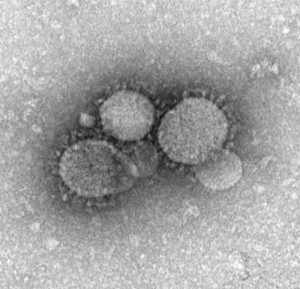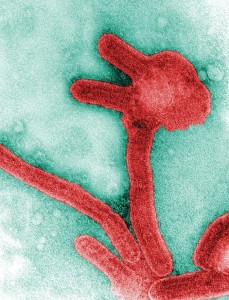With the 24/7 news cycle inundated with the West Africa Ebola Virus Disease (EVD), anyone paying even a little attention knows that Ebola is a very dangerous virus. Depending on the species of virus (there are 4 that infect and cause disease in humans) and the outbreak, the mortality, or fatality rate ranges from 25 to up to 90 percent.
However, EVD is not the only viral disease out there, in which you see a significant percentage of deaths compared to the number infected. Let me introduce you to some other viral diseases with fatality rates higher than 30 percent (the list is not exhaustive, for example I did not include HIV).
9. Middle East Respiratory Syndrome coronavirus (MERS-CoV)

This viral respiratory illness was first reported in Saudi Arabia in 2012. It is caused by a coronavirus called MERS-CoV. Most people who have been confirmed to have MERS-CoV infection developed severe acute respiratory illness. They had fever, cough, and shortness of breath. About 30% of people confirmed to have MERS-CoV infection have died. According to the World Health Organization (WHO), as of July 23, 837 laboratory-confirmed cases of infection with MERS-CoV including at least 291 related deaths have officially been reported to WHO.
8. Hantavirus Pulmonary Syndrome (HPS)
HPS has been confirmed in several countries in the Americas-the United States, Canada, Argentina, Bolivia, Brazil, Chile, Panama, Paraguay, and Uruguay. In the US and Canada, the Sin Nombre hantavirus is responsible for the majority of cases of HPS. The host of the Sin Nombre virus is the deer mouse (Peromyscus maniculatus).
The virus, which is shed in the urine, droppings, and saliva of the rodents, is mainly transmitted to people when they breathe in air contaminated with the virus, although their are also less common ways to contract hantavirus such as via animal bites.
In the US since 1993, the Centers for Disease Control and Prevention (CDC) has reported a total of 639 cases with a fatality rate of 36 percent.
7. Crimean-Congo hemorrhagic fever (CCHF)
CCHF is primarily transmitted to people from ticks and livestock animals. Human-to-human transmission can occur resulting from close contact with the blood, secretions, organs or other bodily fluids of infected persons. CCHF is endemic in Africa, the Balkans, the Middle East and Asian countries south of the 50th parallel north.
The CCHF virus causes severe viral hemorrhagic fever outbreaks, with a case fatality rate of 10–40%.
6. Lassa fever
According to the WHO, Lassa fever is an acute viral hemorrhagic illness caused by Lassa virus, a member of the arenavirus family of viruses. It is transmitted to humans from contacts with food or household items contaminated with rodent excreta. The disease is endemic in the rodent population in parts of West Africa. Person-to-person infections and laboratory transmission can also occur, particularly in the hospital environment in the absence of adequate infection control measures. Diagnosis and prompt treatment are essential.
Only 1% of all Lassa virus infections result in death. However, approximately 15%-20% of patients hospitalized for Lassa fever die from the illness. Lassa fever is also associated with occasional epidemics, during which the case-fatality rate can reach 50% in hospitalized patients.
5. Nipah virus
Nipah virus (NiV) was initially isolated and identified in 1999 during an outbreak of encephalitis and respiratory illness among pig farmers and people with close contact with pigs in Malaysia and Singapore. The disease has also been reported in India and is regularly seen in Bangladesh.
In Bangladesh and India, person-to-person transmission of the virus is regularly reported. This is most commonly seen in the family and caregivers of Nipah virus-infected patients. Transmission also occurs from direct exposure to infected bats. A common example is consumption of raw date palm sap contaminated with infectious bat excretions.
The Dhaka Tribune recently reported that in Bangladesh from 2001-2013, there was 189 cases of NiV resulting in 148 deaths (CFR of 78 percent).
4. Herpes B
B virus infection is caused by a herpes virus. B virus is also commonly referred to as herpes B, monkey B virus, herpesvirus simiae, and herpesvirus B.
The virus is found among macaque monkeys, including rhesus macaques, pig-tailed macaques, and cynomolgus monkeys (also called crab-eating or long-tailed macaques). Macaque monkeys are thought to be the natural host for the virus.
The CDC notes infection with B virus is extremely rare in humans. When it does occur, the infection can result in severe brain damage or death if the patient is not treated soon after exposure. Infection in humans is typically caused by animal bites or scratches or by mucosal contact with body fluid or tissue.
Untreated B virus infections in humans result in an extremely high mortality rate (∼80%) and, consequently, present unique and potentially lethal challenges for individuals handling macaque monkeys or macaque cells and tissues.
3. Lujo hemorrhagic fever (LUHF)
This extremely rare viral hemorrhagic fever (5 cases report) was reported in South Africa from a small, nosocomial cluster of hemorrhagic disease in September-October 2008.
Lujo virus has a rodent host as its reservoir. Humans can contract LUHF through contact with an infected rodent. Contact can be direct or through inhalation of aerosolized Lujo virus from the urine or feces of infected rodents.
Person-to-person transmission of Lujo virus was observed in the small, nosocomial cluster of hemorrhagic disease which resulted in the discovery of the Lujo virus. Of the five cases, four died giving Lujo a CFR of 80%.

2. Marburg Virus Disease (MVD)
According to the WHO, the “cousin” of Ebola Virus Disease was first identified in 1967 during epidemics in Marburg and Frankfurt in Germany and Belgrade in the former Yugoslavia from importation of infected monkeys from Uganda.
The Marburg virus is transmitted by direct contact with the blood, body fluids and tissues of infected persons. Transmission of the Marburg virus also occurred by handling ill or dead infected wild animals (monkeys, fruit bats).
The case-fatality rate for Marburg Virus Disease is between 23-90%, according to the CDC.
1. Rabies
According to the Global Alliance for Rabies Control, Rabies is a viral disease that is transmitted through the saliva or tissues from the nervous system from an infected mammal to another mammal.
The rabies virus attacks the central nervous system causing severely distressing neurological symptoms before causing the victim to die. Without post exposure prophylaxis (rabies vaccine and immunoglobulin) rabies is nearly a certain death sentence. Rabies is the deadliest disease on earth with a 99.9% fatality rate.
Rabies is found on every continent except Antarctica with over 90% of rabies deaths are in Africa, Asia and the Middle East. Estimates are that 55,000 people die from the disease every year. For more infectious disease news and information, visit and “like” the Infectious Disease News Facebook page .


14 thoughts on “The World’s Deadliest Viruses”